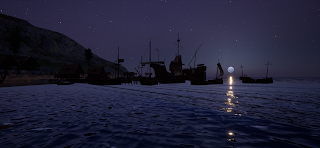Recreating the town of Scarborough, Yorkshire: Post 6: The Port - Cogs, Knarrs, Cobels and Yenikapi
1264 visualization of the Port of Scarborough
13th Century Cog in a drift of snow flakes at the Port of Scarborough
Scarborough's port has played an important, sometimes critical, role in the history of Yorkshire and Britain. This post forms part of a broader exploration of the East Yorkshire coast as a working landscape across long periods of history (and how this knowledge is helping us to develop our animated series on Scarborough starting in the year 1264). Please visit the Scarborough Maritime Heritage Center to learn more about the amazing history of this place.
The South Sands Bay in Scarborough has a well-deserved reputation as a safe place of shelter. In quieter weather, between Scarborough and Filey, lie long stretches of gently sloping sand: South Sands, Cayton Bay, Lebberston, Hunmanby, and Filey itself. These beaches are not merely scenic; from ancient time they were the natural landing infrastructure for shallow-draft vessels: from the unique local fishing designs to the massive flat bottomed boats that transported Roman cavalry and later coastal raiders of the Saxons and Vikings.
Shallow-draft vessels, run gently aground on a shelving beach at low tide, allow disembarkation forward and, particularly with stock or horses, allow control of animals not possible on stone or wooden piers. Sand-landing was used across the ancient world and continued well into the medieval period (my own De-Havilland yacht allows the retraction of its deep keel to permit beach landings). However, sand landings leave little archaeological trace: which may explain why coastal cavalry logistics are so often invisible to us.
Prior the 13th century, we imagine that sand-landing at Scarborough was supplemented by one or more wooden piers extending into deeper water. A preference here would have been to build a longer pier next to small streams (perhaps the now vanished Damyot) to help clear sand from the wooden structure. However, in the early 1250s Royal approval was given for extensive works to be undertaken to reshape the port - perhaps initially a modest quay along the shore line (timber framed with a ballast of rocks) with a couple of wooden piers extending into deeper water. History suggests that sand drift remained an ongoing battle - by the time of Henry VIII, the quay extended further along the bay, and the piers further out into the bay - and extensive dredging was probably necessary.
But we are not here to write history: here is how we use our research for cinematic purposes:
Character study: Port-Reeve Warrin, Scarborough 1264
Simplified version of the changes by 1264 - new piers in distance, old Damyot pier in foreground
Approaching the port, Keep and St Marys in distance, note beacon tower near Keep aids navigation
Approaching Scarborough from York, port to distance right
Approaching Scarborough from north Yorkshire, port to distance right
Navigation/warning beacon on largest curtain tower
As with housing assets, there are few accurate representations of the flat-bottomed early-high medieval trading ships.
To complete the port, we have built Cogs, a variety of Knarr, Mediterranean traders such as the exotic Byzantine Yenikapi and larger galleys, a number of Nordic and continental sea-going trading boats and the local Cobel as an exemplar of local fishing fleet.
A dive into the local maritime environment of the thirteenth century, suggests that the Knarr rather than one of the many variants of Cogs would have been just as likely encountered in Scarborough. Indeed, some suggest that the cog/nef of the Cinque Ports used the Knarr structure on which to build the distinctive castles that now only survive on seals. The Borough seal of Scarborough looks a bit like a Knarr with a defensive tower on the mast. More northern seals (Robert of Wolverston) also looks a bit like the knarr.
Below is a shot from a 1254 set (ten years before the events in the present film) showing the old pier at the mouth of the Damyot - and demonstrating some of the differences between the northern knarr and the southern cog.
Index of posts in the series "Recreating the town of Scarborough, Yorkshire, 1264"
1: Geography

















Comments